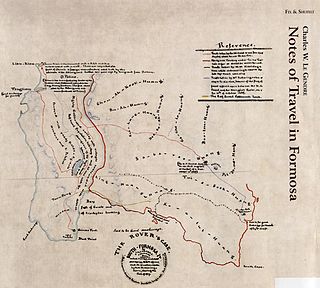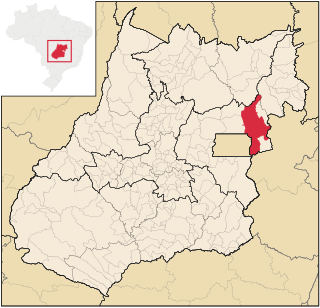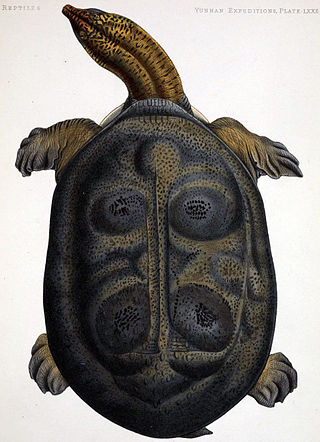
The Taiwan blue magpie, also called the Taiwan magpie, Formosan blue magpie, or the "long-tailed mountain lady", is a bird species in the crow family. It is endemic to Taiwan.

Formosa Province is a province in northeastern Argentina, part of the Gran Chaco Region. Formosa's northeast end touches Asunción, Paraguay, and the province borders the provinces of Chaco and Salta to its south and west, respectively. The capital is Formosa.

A tarantula hawk is a spider wasp (Pompilidae) that preys on tarantulas. Tarantula hawks belong to any of the many species in the genera Pepsis and Hemipepsis. They are one of the largest parasitoid wasps, using their sting to paralyze their prey before dragging it to a brood nest as living food; a single egg is laid on the prey, hatching to a larva which eats the still-living host. They are found on all continents other than Europe and Antarctica.

The Baikal teal, also called the bimaculate duck or squawk duck, is a dabbling duck that breeds in eastern Russia and winters in East Asia.

Dicentra, known collectively as the bleeding-hearts, is a genus containing eight species of herbaceous flowering perennial plants with unique, "heart"-shaped flowers and finely divided foliage. The species are, primarily, native to North America, although several are found in temperate East Asia.

The Rover Incident occurred on 12 March 1867 when the American merchant ship Rover, captained by Joseph Hunt who was accompanied by his wife Mercy G. Beerman Hunt, and en route from Shantou to Niuzhuang, was wrecked off the coast of Taiwan, then ruled by the Qing dynasty. The ship struck a coral reef called Qixingyan near Cape Eluanbi and drifted into the area of Kenting in modern-day Hengchun, Pingtung County, Taiwan. Fourteen American sailors, including Hunt and his wife, were killed by Taiwanese Aborigines in revenge for earlier killings of Kaolut (Koalut/Ku-a-lut/etc) tribe members by foreigners. Subsequently, the U.S. military decided to send a military expedition against the tribe members responsible.

The Ria Formosa lagoon, located in the Algarve, in southern Portugal, is a system of barrier islands that connects to the sea through six inlets. Five of these inlets are natural and have mobility characteristics. The sixth is an artificial inlet that was opened with the purpose of allowing easier access to the port of Faro. In 2010, the lagoon was recognised as one of the country’s seven natural wonders. Following a public vote in which 656,356 voted, the Ria Formosa was announced the winner of the Marine Area category of the ‘7 Maravilhas Naturais de Portugal’.

Olhão, officially known as Olhão da Restauração, is a city and municipality in the Algarve region of southern Portugal. The population of the municipality in 2011 was 45,396, in an area of 130.86 km2 (50.53 sq mi). Located near the regional capital Faro and forming a single urban agglomeration, it is a fishing port and tourist center. Along with Faro, Loulé and Tavira, Olhão forms a conurbation from the eastern and central Algarve.

Samuel Goldwyn Studio was the name that Samuel Goldwyn used to refer to the lot located on the corner of Formosa Avenue and Santa Monica Boulevard in West Hollywood, California, as well as the offices and stages that his company, Samuel Goldwyn Productions, rented there during the 1920s and 1930s. At various times, the location was also known as Pickford–Fairbanks Studios, the United Artists Studio, Warner Hollywood Studios, and its name since 1999, The Lot at Formosa.

Formosa is a municipality located in the state of Goiás, Brazil, approximately 80 kilometers northeast of Brasília. The population was 123,684 in a total area of 5,813.637 km2. Formosa is known for its waterfalls and natural environment. It is a large producer of cattle and grains and is one of the fastest-growing cities in the state.

The Burmese peacock softshell turtle is a species of softshell turtle in the Trionychidae family. It is one of five species in the genus Nilssonia.

Cephalopholis formosa, the Bluelined hind or bluelined rockcod is a species of marine ray-finned fish, a grouper from the subfamily Epinephelinae which is in the family Serranidae which also includes the anthias and sea basses. It is found in the Indo-Pacific where it is associated with reefs. It is sometimes found in the aquarium trade.

The queen coris, also known as the sand wrasse, Queen coris wrasse, Formosan coris, Formosa coris wrasse, Formosa wrasse, Indian Ocean wrasse or Indian sand wrasse, is a species of wrasse native to the Indian Ocean from the Red Sea and the coast of east Africa to Sri Lanka. This species appears in the aquarium trade due to its vibrant colors. A special feature about this species is how much they change from juvenile to adult form, in color, behaviour, and diet.

Tselfatia is an extinct genus of Cretaceous bony fish. Originally described from Djebl Tselfat in Morocco, it has since been discovered at sites in several other countries. The type species, Tselfatia formosa, was named and described in 1943 by French paleontologist Camille Arambourg. A second species, T. dalmatica, was named in 1980 from the Dalmatian Coast of Croatia.
Rhyacophila formosa is a species of free-living caddisfly in the family Rhyacophilidae. It is found in North America.
Rutela formosa, the handsome flower scarab, is a species of shining leaf chafer in the family of beetles known as Scarabaeidae.

Palloptera is a genus of flutter flies in the family Pallopteridae. There are at least 30 described species in Palloptera.
Macrocera formosa is a species of predatory fungus gnats, insects in the family Keroplatidae.
Echthodopa is a genus of robber flies in the family Asilidae. There are at least four described species in Echthodopa.
Echthodopa pubera is a species of robber flies in the family Asilidae.















